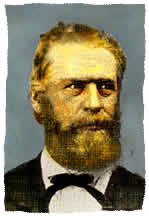|
Some
fought for the Confederacy, some against it and some against
those who fought for either side. The Union had convinced
about 2,200 Cherokees to fight for the North and the Confederacy
had some 1400 of the Cherokees on their side. The Choctaws
and Chickasaws were loyal to the Confederacy but the Creeks
were roughly divided in about half with 1,575 for the North
and 1,695 for the South. Thus the stage was set for a Civil
War with in the Indians Nation on which side they would support
during the war between the North and South.
There
was a brief skirmish between Coopers Indians and a contingent
of the newly formed 9th Texas Cavalry on November 19, near
Round Mountain. A Chief in the Creek Nation, Chief Opothleyahola
had moved his Creeks toward joining the Union. He had attacked
Confederate supplies and he was soon attacked by the Confederate
troops in the area. There was some confusion with Indians
fighting Indians and the Confederate troops not being able
to tell them apart. This problem was soon solved by having
tie red and blue strings tied around the arms of both the
Confederate troops and the Indians they were fighting with.
Three weeks after this skirmish, another one occurred on December
9th. The Texas engaged in this fight were victorious but were
caught in the snow and many became very sick due to exposure
to the elements. Since the threat was real, Cooper called
on McIntosh for help. In a strange twist of ironies, a portion
of Texas Brigade, which included the 11th Texas Cavalry, met
up with Coopers Confederate Indians on December 20, 1961.
The Indians on the Confederate side consisted of some Choctaws
Cherokees and Chickasaws tribes. The opposing Indians were
Chief Opothleyahola warriors of the Creek Nation. They had
engaged Confederate troops earlier at Cimarron River on November
19, 1861 and caused the Confederates engaged to call for reinforcements.
This caused the Confederate command of about 1380 men to venture
into Indian Territory, rendezvousing at Fort Gibson with Coopers
Confederate Indians.
 |
Douglas
H. Cooper was born in Mississippi in 1815. He
served with the 1st Mississippi Rifles in the Mexican
War in 1847.
He was a Federal Indian agent in 1851 and after the war
began was commissioned Colonel of the 1st Choctaw and
Chickasaw Mounted Rifles. He later became a brigadier
General and commanded some 5000 Indians at one point in
the war. He was a champion of Native American rights and
represented the Chickasaw and Choctaws in legal action
against the Untied States. He died in the Chickasaw Nation
in 1879.
|

Part
1 | Part
2 | Part
3 | Part
4 |
Part 5
Part
6| Part
7 |
Part 8| Part
9| Part
10
Part
11 |
Part 12 | Part
13
|